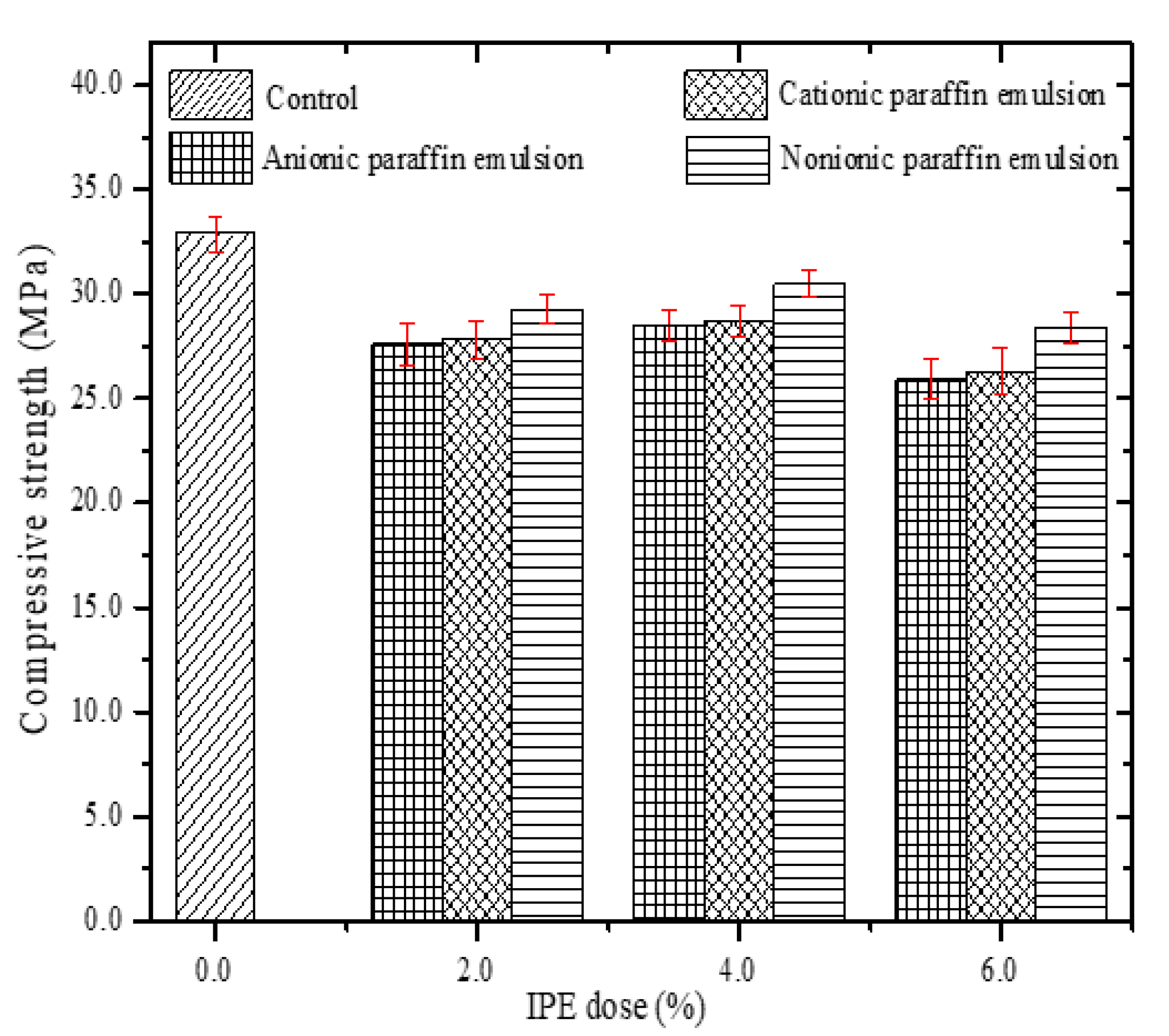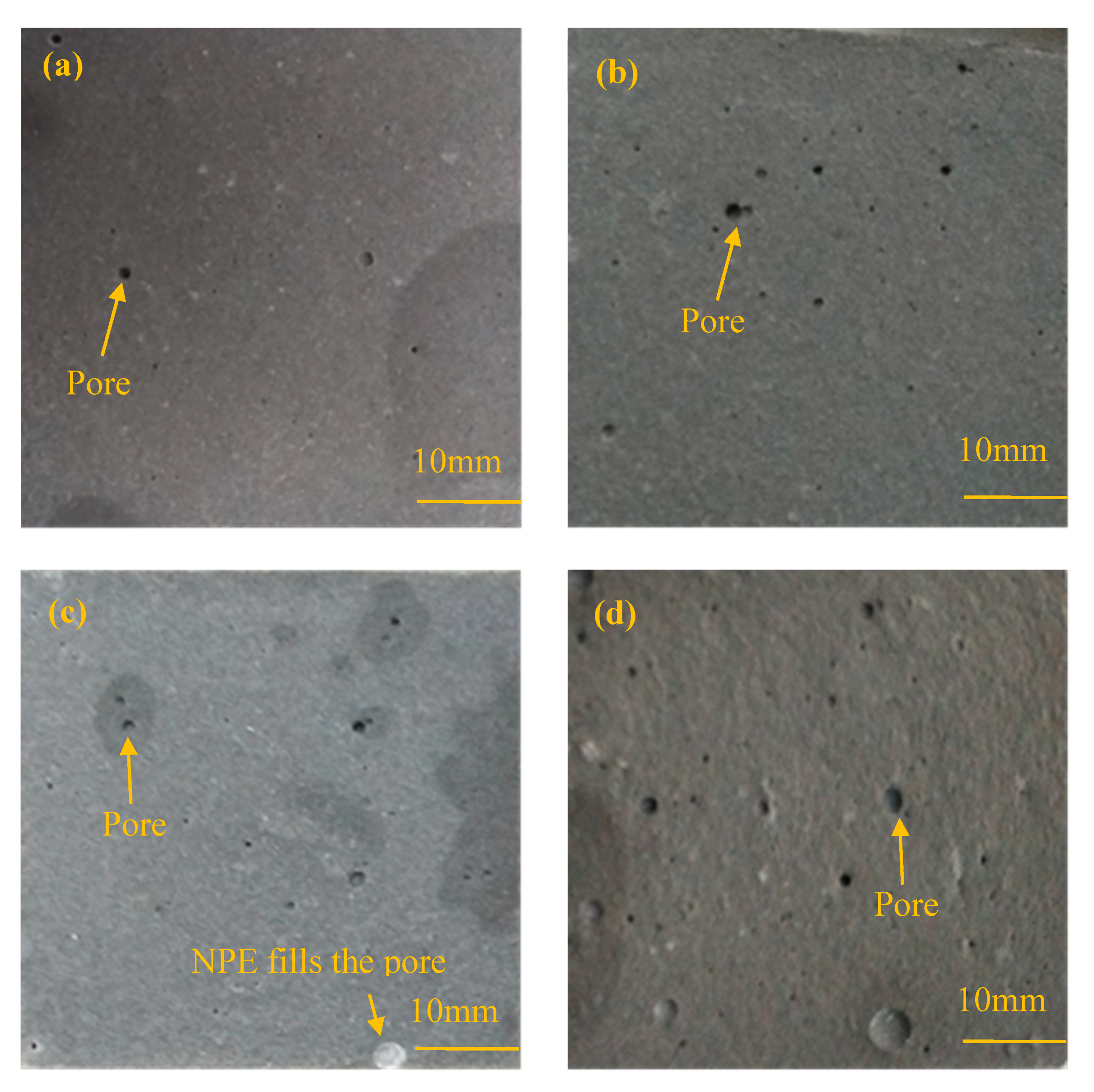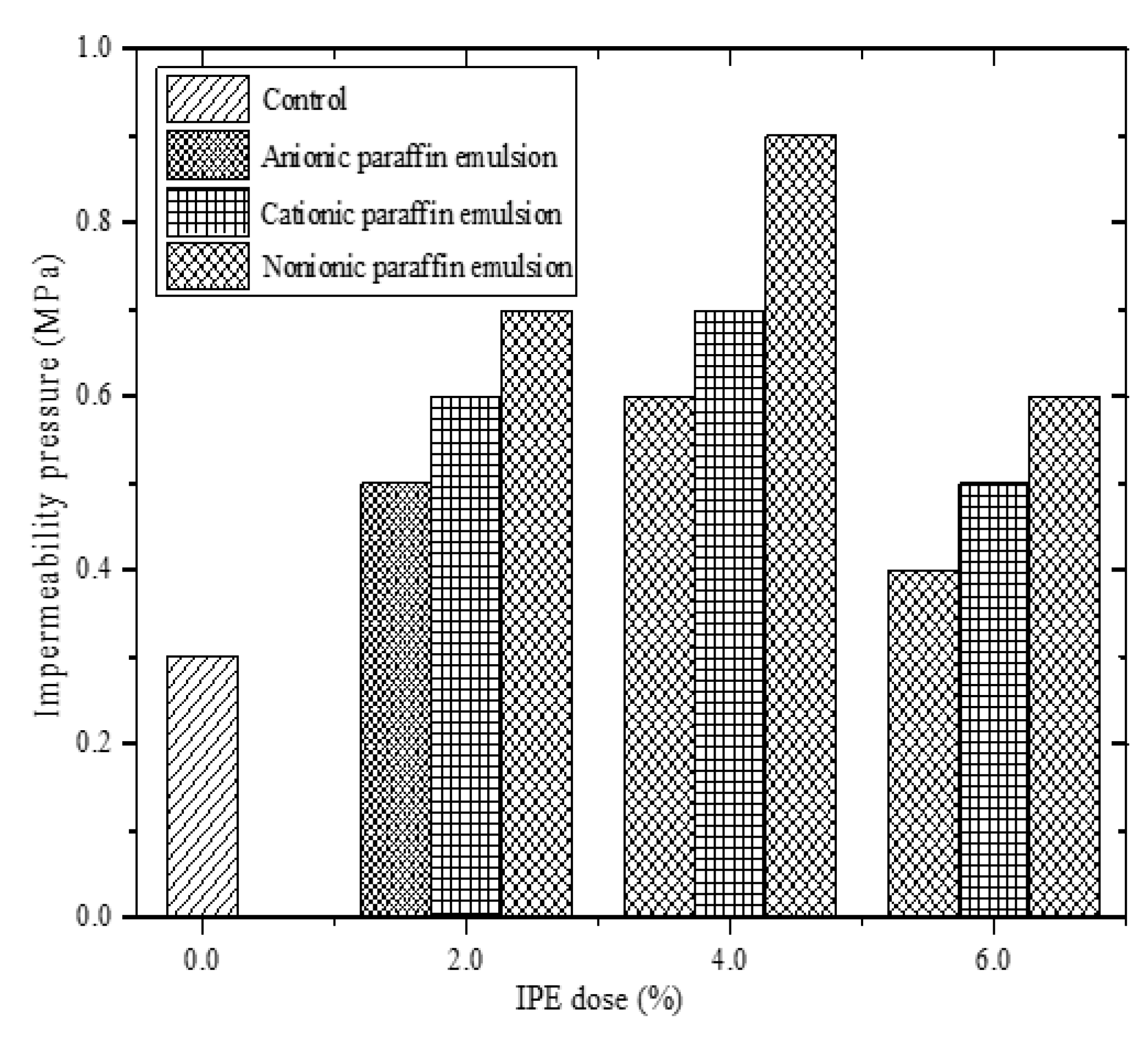Hydrophobicity Improvement of Cement-Based Materials Incorporated with Ionic Paraffin Emulsions (IPEs)
Abstract
1. Introduction
2. Experimental
2.1. Materials
2.2. Preparation of Self-Prepared Ionic Paraffin Emulsions (IPEs)
2.3. Preparation of Specimens
2.4. Test Methods
2.4.1. Fourier Transform Infrared (FTIR) Spectroscopy Test
2.4.2. Compressive Strength Test
2.4.3. Apparent Contact Angle Test
2.4.4. Impermeability Test
2.4.5. Microstructure Tests
3. Correlation Analyses
3.1. Non-Linear Correlation Analysis and Linear Correlation Analysis
3.2. Gray Correlation Analysis
- (1)
- The reference sequence X0(k) and the comparative sequence Xi(k) are selected from the data obtained from various experiments, as shown in Equation (7).where, k = 1, 2, 3, …, n, i = 1,2,3,…,m.
- (2)
- To reduce the influence of the difference between the maximum and minimum values in the sequence, the sequence needs to be normalized, as shown in Equation (8).where, i = 0,1,2,3,…,m.
- (3)
- The gray correlation coefficient is calculated by Equation (9).where, is called the absolute deviation between x0 and xi at point k; is called the tow-grade minimum difference; is called the tow-grade maximum difference; and ρ is the distinguishing coefficient, generally ρ = 0.5.
- (4)
- The relational degree is calculated by Equation (10).
- (5)
- According to the principle of the gray correlation degree analysis, the comparative sequence with a high relational degree is the closest to the reference sequence, which is the most important factor that affects the reference sequence.
4. Results and Discussion
4.1. Characterizations of IPEs
4.1.1. FTIR Analyses
4.1.2. Microstructural Analyses
4.2. Properties of Cement-Based Materials with IPEs
4.2.1. Compressive Strength
- (1)
- Paraffin particles can affect cement hydration, leading to a higher number of internal pores in the cement paste specimens with IPEs than that in the control group. Therefore, the compactness of cement paste specimens with IPEs decreases, leading to a lower compressive strength of cement paste specimens with IPEs than that of the control group.
- (2)
- Paraffin particles mainly play a role in filling the internal pores of cement paste specimens to reduce the porosity and improve the compressive strength at an IPE dose of less than 4.0% (except the control group). Thus, the compressive strength of cement paste specimens increases with the IPE dose.
- (3)
- Excess paraffin particles adsorbed on the cement surface can affect cement hydration when the IPE dose is greater than 4.0%. Moreover, the network connection among the cement hydrates is affected due to paraffin particles, which increases the porosity of cement paste specimens. Therefore, the compressive strength of cement paste specimens decreases with the increase in the IPE dose.
4.2.2. Impermeability Results
4.2.3. Apparent Contact Angle
4.2.4. Microstructures
- (1)
- According to the Cassie–Baxter model [23,24], water does not easily wet the cement surface due to the hydrophobicity of IPEs, leading to the interception of gas on the cement surface to produce a gas film and hindering the complete hydration of cement. Thus, the amount of hydrates of the cement paste with IPEs is less than that of the control group, leading to lower compressive strength and compactness for the cement paste with IPEs than those for the control group.
- (2)
- Paraffin particles in APE and CPE can be adsorbed on cement particles or hydrates more easily than those in NPE, which hinders the hydration of cement and decreases the compactness of cement hydrates. Therefore, the content of flaky calcium hydroxide in the cement paste with APE and CPE is greater than that in the cement paste with NPE; the contents of aciculate ettringite crystal and hydrated calcium silicate gel in the cement paste with APE and CPE are less than those in the cement paste with NPE, leading to lower compressive strength, impermeability, and apparent contact angle for the cement paste with APE and CPE than those for the cement paste with NPE.
4.2.5. Correlation Analyses
5. Conclusions and Recommendations
- (1)
- The impermeability of cement mortar specimens with IPEs reflects exceptional hydrophobicity. Notably, cement mortar with 4.0% NPE exhibits outstanding hydrophobicity.
- (2)
- The apparent contact angle of cement powder with IPEs is significantly higher than that of the control group, indicating that IPEs exhibit excellent hydrophobicity. Notably, the apparent contact angle of cement powder with NPE is near 90°.
- (3)
- The microstructures of cement paste with NPE are clearer than those of the cement paste with APE and CPE. Meanwhile, the microstructures of cement paste with NPE are similar to that of the control group.
- (4)
- The apparent contact angle is the main factor that affects the impermeability. Notably, attention should be focused on the compressive strength when considering the effect of impermeability and apparent contact angle on the hydrophobicity.
- (5)
- The compressive strength of cement-based materials with 4.0% NPE is considerably similar to that of the control group. However, NPE adversely affects the compressive strength. Therefore, we recommend that NPE can be mixed with mineral admixtures to improve the compressive strength of cement-based materials.
6. Further Research
Author Contributions
Funding
Conflicts of Interest
References
- Zheng, K.; Yang, X.; Chen, R.; Xu, L. Application of a capillary crystalline material to enhance cement grout for sealing tunnel leakage. Constr. Build. Mater. 2019, 214, 497–505. [Google Scholar] [CrossRef]
- Azarsa, P.; Gupta, R.; Biparva, A. Inventive Microstructural and Durability Investigation of Cementitious Composites Involving Crystalline Waterproofing Admixtures and Portland Limestone Cement. Materials 2020, 13, 1425. [Google Scholar] [CrossRef]
- Min, H.; Song, Z. Investigation on the Sulfuric Acid Corrosion Mechanism for Concrete in Soaking Environment. Adv. Mater. Sci. Eng. 2018, 2018, 1–10. [Google Scholar] [CrossRef]
- Wang, Z.; Wu, J.; Zhao, P.; Dai, N.; Zhai, Z.; Ai, T. Improving cracking resistance of cement mortar by thermo-sensitive poly N-isopropyl acrylamide (PNIPAM) gels. J. Clean. Prod. 2018, 176, 1292–1303. [Google Scholar] [CrossRef]
- Hu, X.; He, C.; Feng, K.; Liu, S.; Walton, G. Effects of polypyrrole coated rebar on corrosion behavior of tunnel lining with the combination effect of sustained loading and pre-existing cracks when exposed to chlorides. Constr. Build. Mater. 2019, 221, 318–331. [Google Scholar] [CrossRef]
- He, R.; Dai, N.; Wang, Z. Thermal and Mechanical Properties of Geopolymers Exposed to High Temperature: A Literature Review. Adv. Civ. Eng. 2020, 2020, 1–17. [Google Scholar] [CrossRef]
- Bušić, R.; Benšić, M.; Miličević, I.; Strukar, K. Prediction Models for the Mechanical Properties of Self-Compacting Concrete with Recycled Rubber and Silica Fume. Materials 2020, 13, 1821. [Google Scholar] [CrossRef] [PubMed]
- Liu, P.; Gao, Y.; Wang, F.; Yang, J.; Yu, X.; Zhang, W.; Yang, L. Superhydrophobic and self-cleaning behavior of Portland cement with lotus-leaf-like microstructure. J. Clean. Prod. 2017, 156, 775–785. [Google Scholar] [CrossRef]
- Wang, F.; Pi, J.; Song, F.; Feng, R.; Xu, C.; Wang, X.-L.; Wang, Y. A superhydrophobic coating to create multi-functional materials with mechanical/chemical/physical robustness. Chem. Eng. J. 2020, 381, 122539. [Google Scholar] [CrossRef]
- He, R.; Zheng, S.; Gan, V.J.; Wang, Z.; Fang, J.; Shao, Y. Damage mechanism and interfacial transition zone characteristics of concrete under sulfate erosion and Dry-Wet cycles. Constr. Build. Mater. 2020, 255, 119340. [Google Scholar] [CrossRef]
- Wang, Z.; Wang, P.; Guo, H.; Wang, X.; Li, G. Adhesion Improvement between RAP and Emulsified Asphalt by Modifying the Surface Characteristics of RAP. Adv. Mater. Sci. Eng. 2020, 2020, 1–10. [Google Scholar] [CrossRef]
- Izarra, I.; Cubillo, J.; Serrano, A.; Rodríguez, J.; Carmona, M. A hydrophobic release agent containing SiO2-CH3 submicron-sized particles for waterproofing mortar structures. Constr. Build. Mater. 2019, 199, 30–39. [Google Scholar] [CrossRef]
- Li, G.; Liu, S.; Niu, M.; Liu, Q.; Yang, X.; Deng, M. Effect of granulated blast furnace slag on the self-healing capability of mortar incorporating crystalline admixture. Constr. Build. Mater. 2020, 239, 117818. [Google Scholar] [CrossRef]
- Hua, W.; Kar, P.; Roy, P.; Bu, L.; Shoute, L.C.T.; Kumar, P.; Shankar, K. Resistance of Superhydrophobic Surface-Functionalized TiO2 Nanotubes to Corrosion and Intense Cavitation. Nanomaterials 2018, 8, 783. [Google Scholar] [CrossRef]
- Liu, J.; Janjua, Z.A.; Roe, M.; Xu, F.; Turnbull, B.; Choi, K.-S.; Hou, X. Super-Hydrophobic/Icephobic Coatings Based on Silica Nanoparticles Modified by Self-Assembled Monolayers. Nanomaterials 2016, 6, 232. [Google Scholar] [CrossRef]
- Vogel, F.; Sovják, R.; Pešková, Š. Static response of double shell concrete lining with a spray-applied waterproofing membrane. Tunn. Undergr. Space Technol. 2017, 68, 106–112. [Google Scholar] [CrossRef]
- Li, R.; Hou, P.; Xie, N.; Ye, Z.; Cheng, X.; Shah, S.P. Design of SiO2/PMHS hybrid nanocomposite for surface treatment of cement-based materials. Cem. Concr. Compos. 2018, 87, 89–97. [Google Scholar]
- Feng, Z.; Wang, F.; Xie, T.; Ou, J.; Xue, M.; Li, W. Integral hydrophobic concrete without using silane. Constr. Build. Mater. 2019, 227, 116678. [Google Scholar] [CrossRef]
- Zhu, Y.-G.; Kou, S.-C.; Poon, C.-S.; Dai, J.-G.; Li, Q.-Y. Influence of silane-based water repellent on the durability properties of recycled aggregate concrete. Cem. Concr. Compos. 2013, 35, 32–38. [Google Scholar] [CrossRef]
- Ministry of Housing and Urban-Rural Development of the People’s Republic of China. Standard for Test Method of Basic Properties of Construction Mortar, JGJ/T 70-2009; China Architecture & Building Press: Beijing, China, 2009. [Google Scholar]
- Wang, Z.; Dai, N.; Wang, X.; Zhang, J.; Guo, H. Laboratory investigation on effects of microwave heating on early strength of cement bitumen emulsion mixture. Constr. Build. Mater. 2020, 236, 117439. [Google Scholar] [CrossRef]
- Zhenjun, W.; Nan, D.; Xiaofeng, W.; Gang, L.; Haoyan, G. Early-stage road property improvements of cold recycled asphalt emulsion mixture with microwave technology. J. Clean. Prod. 2020, 263, 121451. [Google Scholar] [CrossRef]
- Deng, Y.; Mager, D.; Bai, Y.; Zhou, T.; Liu, Z.; Wen, L.; Wu, Y.; Korvink, J.G. Inversely designed micro-textures for robust Cassie–Baxter mode of super-hydrophobicity. Comput. Methods Appl. Mech. Eng. 2018, 341, 113–132. [Google Scholar] [CrossRef]
- Liu, T.; Chen, Z.; Kim, C.-J. A dynamic Cassie–Baxter model. Soft Matter 2015, 11, 1589–1596. [Google Scholar] [CrossRef] [PubMed]














| Density/(g/cm3) | Average Particle Size/μm | Setting Time/min | Flexural Strength/MPa | Compressive Strength/MPa | Main Chemical Composition/% | ||||
|---|---|---|---|---|---|---|---|---|---|
| Initial | Final | 3d | 28d | 3d | 28d | CaO | SiO2 | ||
| 3.150 | 20.786 | 141 | 233 | 3.8 | 6.2 | 18.9 | 35.8 | 60.1 | 20.8 |
| Density/(g/cm3) | Mud Content/(%) | Fineness Modulus |
|---|---|---|
| 2.600 | 1.5 | 2.76 |
| Melting Point/(°C) | Containing Oil/(m/m) | Penetration Degree/(25 °C, 100g, 1/10mm) | Color Number | Water-Soluble Acid or Alkali | Mechanical Impurities and Moisture |
|---|---|---|---|---|---|
| 52–54 | 0.55 | 15 | +30 | None | None |
| IPE (%) | Cement (g) | Water (g) | IPE (g) |
|---|---|---|---|
| 0.0 | 1350.0 | 472.5 | 0 |
| 2.0 | 1350.0 | 456.3 | 27.0 |
| 4.0 | 1350.0 | 440.1 | 54.0 |
| 6.0 | 1350.0 | 423.9 | 81.0 |
| IPE (%) | Cement (g) | Sand (g) | Water (g) | IPE (g) |
|---|---|---|---|---|
| 0.0 | 675.0 | 1012.5 | 236.3 | 0 |
| 2.0 | 675.0 | 1012.5 | 228.2 | 13.5 |
| 4.0 | 675.0 | 1012.5 | 220.1 | 27.0 |
| 6.0 | 675.0 | 1012.5 | 212.0 | 40.5 |
| Correlation | Properties | Impermeability Pressure |
|---|---|---|
| Gray correlation | Apparent contact angle | 0.77376 |
| Compressive strength | 0.55648 | |
| Non-linear correlation | Apparent contact angle | 0.82002 |
| Linear correlation | Compressive strength | 0.66091 |
© 2020 by the authors. Licensee MDPI, Basel, Switzerland. This article is an open access article distributed under the terms and conditions of the Creative Commons Attribution (CC BY) license (http://creativecommons.org/licenses/by/4.0/).
Share and Cite
Huo, J.; Wang, Z.; Guo, H.; Wei, Y. Hydrophobicity Improvement of Cement-Based Materials Incorporated with Ionic Paraffin Emulsions (IPEs). Materials 2020, 13, 3230. https://doi.org/10.3390/ma13143230
Huo J, Wang Z, Guo H, Wei Y. Hydrophobicity Improvement of Cement-Based Materials Incorporated with Ionic Paraffin Emulsions (IPEs). Materials. 2020; 13(14):3230. https://doi.org/10.3390/ma13143230
Chicago/Turabian StyleHuo, Jinyang, Zhenjun Wang, Haoyan Guo, and Yongfeng Wei. 2020. "Hydrophobicity Improvement of Cement-Based Materials Incorporated with Ionic Paraffin Emulsions (IPEs)" Materials 13, no. 14: 3230. https://doi.org/10.3390/ma13143230
APA StyleHuo, J., Wang, Z., Guo, H., & Wei, Y. (2020). Hydrophobicity Improvement of Cement-Based Materials Incorporated with Ionic Paraffin Emulsions (IPEs). Materials, 13(14), 3230. https://doi.org/10.3390/ma13143230




